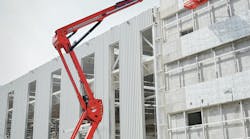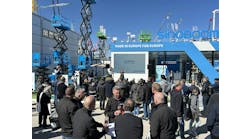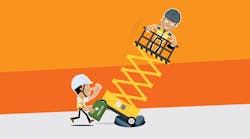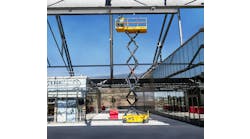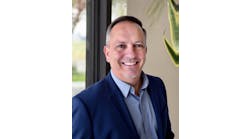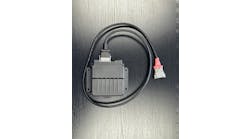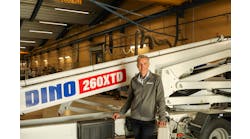Interview with LGMG’s Dickey Bennett and Mark Elton: Robust Features
Dickey Bennett, director of key accounts sales, LGMG, and Mark Elton, director of research & development, LGMG, talk with RER about the growing popularity of larger boomlifts, durability and safety features, automated manufacturing advancements, hybrid popularity, and more.
What do you see as some of the new trends in mobile elevating work platforms and telehandlers (not just with your company’s products). What are customers particularly looking for?
Bennett, Elton: One significant trend in the MEWP industry is the growing popularity of larger booms, particularly those over 85 feet. Models in the 120 to 125-foot range, and even extremely tall booms exceeding 200 feet, are becoming more common as job sites demand machines that can handle greater heights.
In addition, the availability of more robust standard features has become a priority for both manufacturers and customers. At LGMG, we have made features such as cylinder bellows and boom wipers standard inclusions on all booms. These bellows help keep dirt and grime out of critical components, like cylinder rods, extending the life and reliability of the machines. Similarly, our upper control box covers are standard on all LGMG booms to prevent accidental activation of the controls and protect them from the elements, which enhances both safety and machine durability.
Leak containment systems are also becoming a standard feature across the industry, particularly on slab scissor lifts. These systems help manage hydraulic leaks, ensuring job sites remain clean and safe. While many manufacturers offer leak containment as an option, LGMG has made it a standard feature on our scissor lifts, ensuring customers are provided with a more environmentally responsible machine without the need to add additional options.
These trends demonstrate how manufacturers are focused on building more durable, safer, and environmentally friendly machines that cater to the evolving needs of customers while staying aligned with regulatory requirements.
What improvements are being made in the aerial industry in regard to safety, in your products and in the industry as a whole? Are there particular areas of safety you feel need to be addressed more, i.e., falls from height, electrocutions, entrapments, tools falling out of platforms, etc.?
Bennett, Elton: Safety continues to be a major focus within the aerial industry, and there have been several advancements both in LGMG's products and across the industry. One example is the introduction of perimeter lighting on scissor lifts, which provides a visual safety box around the machine. This system ensures that people nearby can clearly see the boundaries of the work zone, helping to prevent them from entering areas where they could be at risk of falling objects or tools. This type of visual cue enhances overall job site safety, particularly when working in busy environments.
Additionally, anti-collision/crush bars on the upper control panels have become a standard feature across most boom lifts, including those from LGMG. LGMG has introduced a bar design, which has been well-received by customers. This system ensures that crush protection is active and not bypassed in frustration when operating in tight spaces.
These safety measures reflect an industry-wide commitment to preventing accidents and improving operator safety, both for those using the machines and for those working around them.
How much have rental companies improved in regard to safety practices and training their customers in safety in recent years? How would you like to see improvement in this area?
Bennett, Elton: One innovative safety practice that has made a significant impact in recent years is the keypad system. This system assigns individual access codes to subcontractors, ensuring that only authorized and trained operators can use the equipment. By limiting machine access to specific individuals, it not only enhances safety but also tracks machine usage by subcontractors, allowing for accurate tracking of billable hours.
This approach has improved accountability on job sites and has been particularly useful for rental companies and contractors managing multiple subcontractors. The keypad system reduces the risk of untrained personnel operating the machines, thereby lowering the chances of accidents while also offering a clear record of who used the equipment and when.
What are the main new developments in your company’s products?
Bennett, Elton: At LGMG, we are proud to enhance our product offerings and manufacturing processes continuously. A significant development has been the establishment of our state-of-the-art facility in Monterrey, Mexico, where automation plays a central role in ensuring high-quality production.
One key innovation is integrating automated welding systems throughout our manufacturing line. This technology guarantees precise, consistent welds on every machine, which contributes to greater structural integrity and improved safety across our mobile elevating work platforms (MEWPs). By eliminating variations inherent in manual processes, automated welding allows us to achieve exact specifications and produce components that are consistently durable and reliable under heavy usage.
Additionally, LGMG’s 100-percent automated electrocoating process ensures a flawless finish, enhancing both the durability and appearance of every machine. Each component is seamlessly moved through the electrocoating process by an aerial conveyor system, ensuring that the paint and protective coatings are applied evenly and consistently across all units. With this focus on automation and quality, LGMG continues to deliver equipment that rental companies can trust, providing unmatched performance and longevity on any job
We continually ask manufacturers and rental companies about electric and hybrid aerial machines, and we find demand and acceptance is increasing each year, along with improved charging infrastructure on jobsites. Do you agree with this? What are your expectations for this market in the foreseeable future, particularly in rental?
Bennett, Leon: The demand for electric and hybrid machines is rising, particularly for booms. However, challenges with charging infrastructure on job sites still impede widespread adoption. Hybrid systems in rough terrain scissors and booms are becoming more popular due to the demand for environmentally friendly solutions. That said, full electrification for larger machines, like telehandlers, remains limited due to cost and power constraints.
